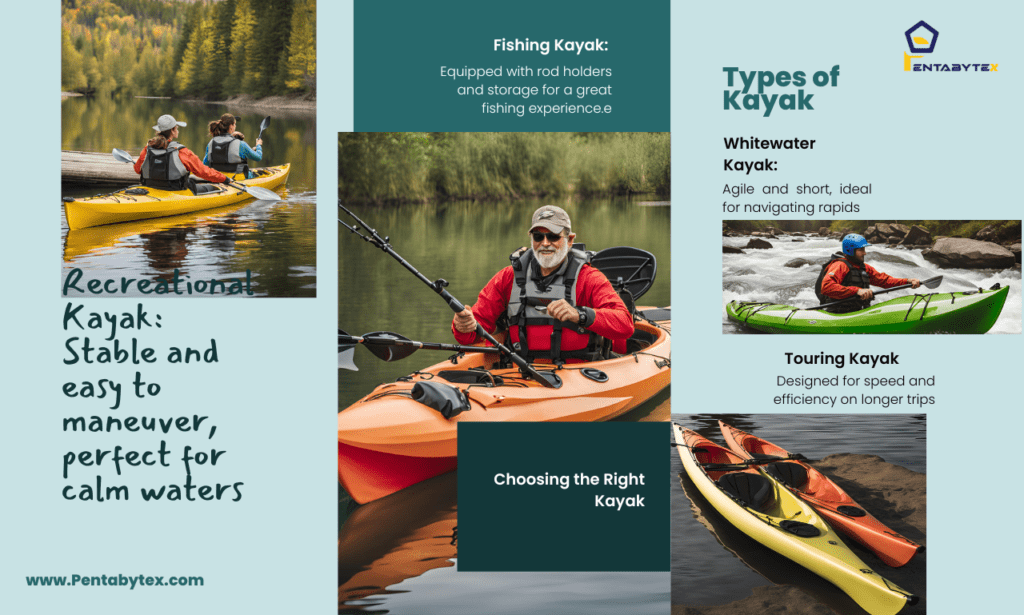One of the most thrilling and fulfilling water activities involving gliding on water bodies, kayaking is considered one of the best recreational activities to indulge in. If you need more experience in how to kayak or need a quick refresher on how to paddle, select the equipment, and execute basic maneuvers, read this post.
At the end of this article, you should be able to embark on your kayaking trips properly, and a few Highlights of other important tips for your kayaking adventure.
What Is Kayaking?
kayaking is a type of water sport in which people navigate a small vessel known as a kayak. Kennels are usually built for one or two persons and are available in many models for a given class of water. While canoes have an uncovered top, kayaks have a decked coaming which offers extra protection for the paddler and makes the kayak less prone to capsizing in turbulent waters. These fundamental how-to kayak instructions and other kayaking tips will assist you in your initial endeavors.
How to Kayak: Choosing the Right Kayak for Your Adventure

Choosing the right kayak is simply important when it comes to planning for a good time. Here’s how to choose the right kayak to get started, along with some kayaking tips:
1. How to Kayak: Understanding Different Kayak Types
- Recreational Kayaks: Best suited for lake paddling and the weak currents of the rivers, these kayaks are not only steady but also easily controlled. Get more information about kayaking with recreational kayaks and other useful tips for kayaking. Read more about recreational kayaks.
- Touring Kayaks: They are more suitable for long journeys because of their speed and tracking capabilities. Learn some guidelines on how to kayak with touring kayaks and some kayaking techniques. Explore touring kayaks.
- Whitewater Kayaks: These are shorter and more maneuverable kayaks designed for use in rough water and rapids. Learn about beginning whitewater kayaking and some other useful tips for kayaking. Check out whitewater kayaks.
- Fishing Kayaks: They come with features such as; fishing rod holders, and storage areas among others, ideal for fishing enthusiasts. Fishing while kayaking is an activity that many fishermen like to do, so to make this task easier we show you the best tips to do it. Learn about fishing kayaks.
2. Size and Fit
- Length: The longer the kayak the better it tracks and it is faster but it can be a bit cumbersome to maneuver. Again, the smaller kayaks are more maneuverable and easier to control.
- Width: Caman smaller and narrower kayaks are faster than the wider ones, but they also offer less stability.
3. Material
- Plastic: Sturdy and inexpensive, good for the basics.
- Fiberglass: Less bulky and greater performance compared with traditional bikes but costlier.
- Inflatable: Teardrop-shaped, foldable, and lightweight, yet not as rugged and sturdy as the hard-shell kayaks.
Essential Gear for How to Kayak Safely

To ensure a safe and enjoyable experience, here’s how to kayak with the essential gear, along with some kayaking tips to keep in mind:
1. Paddle
A good enough paddle to use while paddling is also important while practicing kayaking. Paddles are available in various designs and lengths, so, paddle size has to be chosen based on the size and design of the kayak and personal preference.
Here are some important tips to guide you when choosing the right paddle for your kayaking. Learn how to choose the right paddle.
2. PFD (Personal Flotation Device)
One always needs to have a PFD for safety reasons. Ensure the product sits well and is easy to wear. Some recommendations for choosing the correct PFD to ensure your safety when kayaking, plus these additional tips. Find out more about PFDs.
3. Helmet:
There is nothing wrong with wearing a helmet while kayaking especially if you will be going through shallow water or area with possible obstacles. Learn what type of helmet is safe to wear for kayaking and some guidelines important to follow when going kayaking. Discover helmets for kayaking.
4. Dry Bag:
This is a perfect tool for keeping your important items dry. They are waterproof and can withstand splashes or immersion to protect your gear. The video below explains how to kayak with dry bags for safer kayaking, and here are some tips for protecting your gear. Explore dry bags.
Basic Kayaking Techniques: How to Kayak for Beginners

The next crucial aspect that a kayak enthusiast must figure out is how to kayak. Here are the basic techniques to get you started, along with some kayaking tips to improve your skills:
1. Getting In and Out of the Kayak
Getting in and out of a kayak is somewhat challenging at first. Here’s how to kayak from the start, including some kayaking tips for a smooth entry and exit:
- Enter: Launch the kayak in shallow water. Stand behind the kayak place your legs over the boat and sit on the edge, then swing your legs into the cockpit. Just slide your body into the shot while backing up and keeping your weight forward.
- Exit: Paddle to shallow water, turn the kayak sideways, and to exit push your legs over the side of the kayak.
2. Holding the Paddle
Proper paddle grip is crucial for efficiency and comfort:
- Grip: The choice of the holding position relates to the grip of the paddle whereby the hands are placed about the width of the shoulders apart. The palms should be downward and the elbows somewhat flexed.
- Posture: Keep your backbone straight but avoid tensing your back muscles. Your upper body should turn in the water following every stroke.
3. Basic Strokes
Mastering basic strokes will help you navigate effectively:
- Forward Stroke: Hold the paddle horizontally facing forward and use the hands to draw it from front to back across the water in front of the feet. This stroke helps you move forward.
- Reverse Stroke: To move backward, reverse the forward stroke. In this, pull the paddle towards you.
- Sweep Stroke: This stroke assists in turning. Slide the paddle horizontally from front to back on one side of the kayak.
4. Stopping and Steering
- Stopping: Afterwards, to stop, it is essential to give a forward stroke and follow it with a reverse stroke to come to a halt.
- Steering: Perform a sweep stroke on one side of the pool to turn in that direction. For sharper turns, use sweep strokes from one side and then switch to the other.
Safety Tips for Kayaking
This means that the safety of the individuals involved in the construction projects should always be given utmost consideration. Here’s how to kayak safely with these tips:
- Always Wear a PFD: This is true even for the best swimmers, and a PFD is impossible to ignore.
- Check Weather Conditions: It is important not to attempt any kayaking trips during inclement weather and choppy water.
- Know Your Limits: It is recommended to go from shallow water to deep water gradually.
- Inform Someone: Tell someone of your intentions and when you are likely to be back.
Essential Kayaking Skills: How to Kayak Effectively
As you learn how to kayak, avoid these mistakes to have a better experience and improve your skills. These kayaking tips will help you avoid pitfalls:
- Improper Paddling Technique: Lack of proper technique in practice leads to many troubles such as tiredness and low productivity. Get to know how to kayak, including proper paddling, and take the following information as kayaking tips for efficiency. Learn more about common paddling mistakes.
- Overloading the Kayak: The additional weight may have an impact on the stability of the bike and its speed. Research the carrying capacity of the specific kayaks to be used and follow the tips provided here on how to pack efficiently. Check kayak weight limits.
- Ignoring Weather Conditions: It is good to consult the weather forecast before you set out.
General Information on How to Kayak
For more detailed information and resources on how to kayak, check out these websites. They also offer valuable kayaking tips:
- American Canoe Association: Provides information on how to train for kayaking and various measures that should be taken in case of an emergency.
- Paddling. com: A good source of kayak reviews and buying advice.
- Kayak Forums: To receive valuable insights and recommendations from other users who share the same passion, and engage in discussions.
Conclusion
kayaking is one of the best recreational activities and this is correct since it serves as an adventure tool and reduces stress. The tips and tricks such as the selection of the right kayak, mastering special techniques and tricks, and other precaution measures among others will be helpful to get the best out of your kayaking experience.
Whether it is in a serene lake or amidst the thrilling white waters, the skills and knowledge that one gets along with these kayaking tips will keep your experience safe and fun.
Explore more insightful blogs from Pentabytex.








